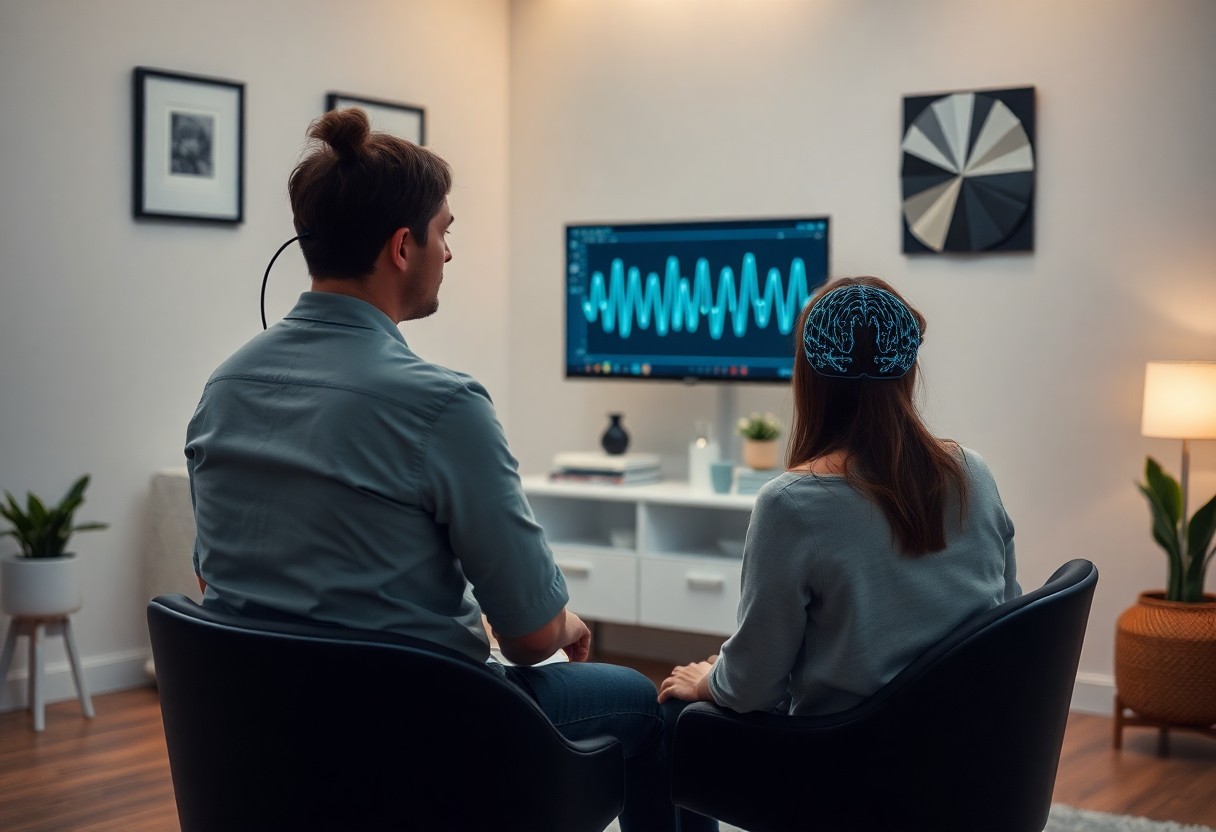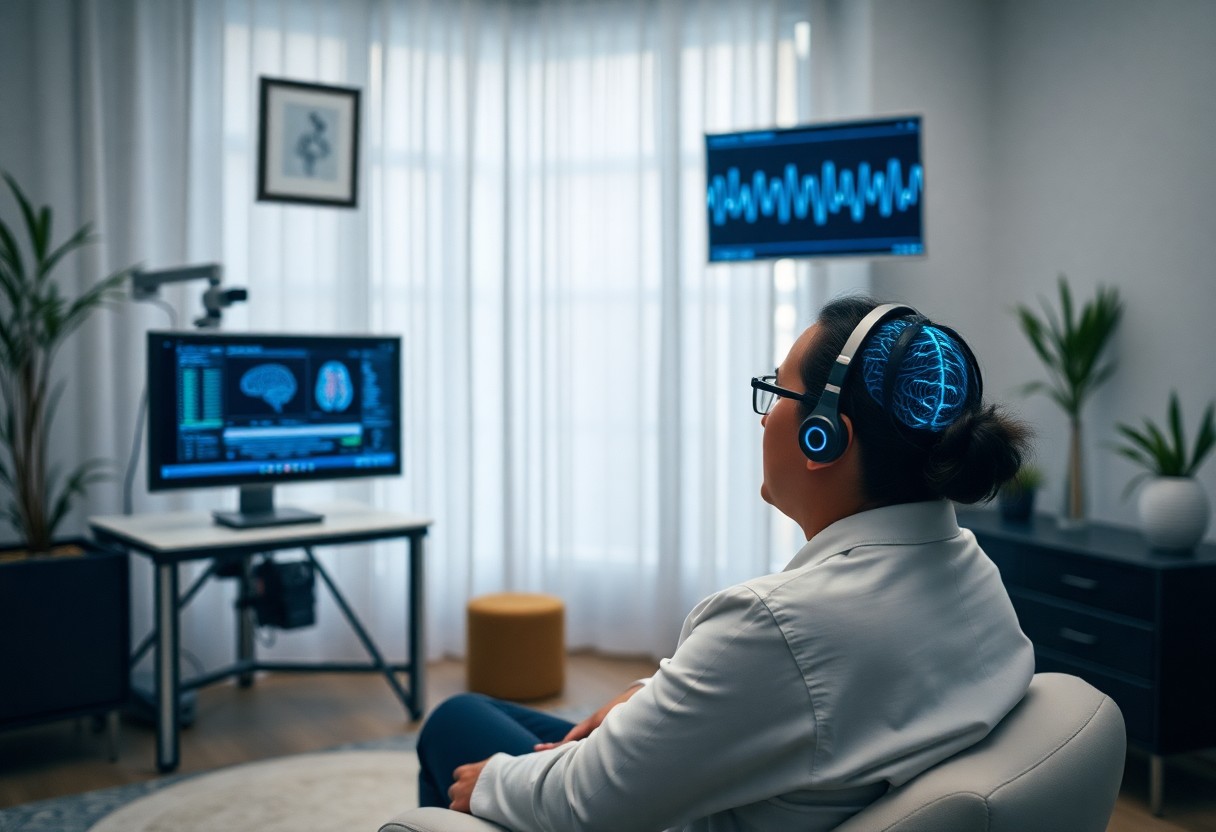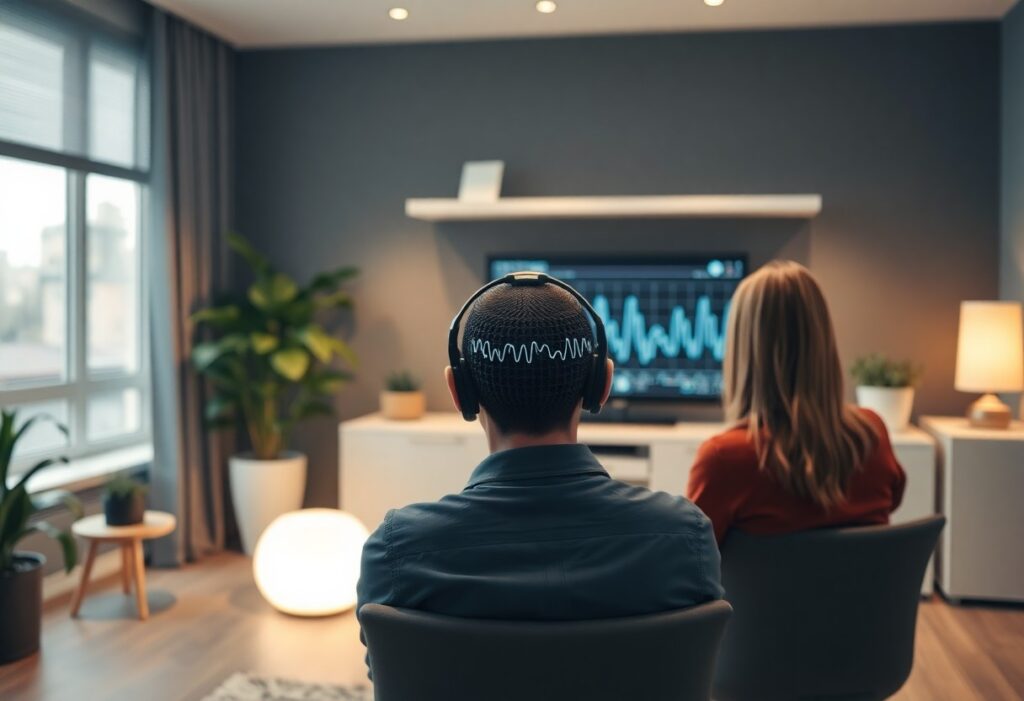Neurofeedback is an innovative approach that can significantly help you manage and reduce the symptoms of panic attacks. By training your brain to self-regulate its activity, neurofeedback empowers you to achieve a calmer mental state, making it easier to cope with anxiety. This technique has gained recognition for its effectiveness and is an excellent alternative to traditional treatment methods. To learn more about how this method can assist you, explore this Neurofeedback Treatment for Anxiety & Panic Attacks.

Key Takeaways:
- Neurofeedback provides real-time data on brain activity, aiding individuals in learning how to regulate their emotional responses during panic attacks.
- Training sessions can enhance the ability to control physiological responses, potentially decreasing the frequency and intensity of panic episodes.
- Complementary therapy shows promise when combined with traditional treatments, such as therapy and medication, for a more comprehensive approach to panic disorder management.
Understanding Panic Attacks
Definition and Symptoms
Your understanding of panic attacks begins with their definition as sudden episodes of intense fear or discomfort that peak within minutes. Symptoms can include heart palpitations, shortness of breath, dizziness, sweating, and a sense of impending doom. You may find that these symptoms often lead you to believe you are having a heart attack or losing control.
Causes and Triggers
Definition of panic attacks encompasses various causes, including genetic predisposition, brain chemistry, and stressful life events. You might notice that certain situations, such as crowded places or public speaking, could trigger your panic attacks. Anxiety disorders can also be linked, as they often coexist with panic attacks.
Another common aspect of understanding panic attacks involves identifying specific triggers in your life. These triggers can be situational, such as driving or flying, or emotional, like feelings of stress or sadness. By recognizing your personal triggers, you can better prepare for and manage the anxiety that accompanies panic attacks.
Impact on Daily Life
Against a backdrop of everyday life, panic attacks can significantly disrupt your routine and peace of mind. You may find yourself avoiding places or situations where past attacks occurred, limiting your social interactions and personal growth.
Panic attacks can lead to increased anxiety about potential incidents, resulting in a cycle that affects your well-being and daily activities. The avoidant behavior that emerges can restrict your lifestyle, impacting relationships, work performance, and overall emotional health. Understanding this impact is vital to finding effective treatment options that can help you regain control.
Overview of Neurofeedback
While many individuals seek alternative therapies for anxiety, neurofeedback has emerged as a promising solution for those dealing with panic attacks. For an in-depth look at its potential, consider exploring the Efficacy Evaluation of Neurofeedback-Based Anxiety Relief.
Definition and Mechanism
Against conventional therapeutic approaches, neurofeedback is a type of biofeedback that involves training individuals to control their brain activity. Through real-time monitoring of brain waves, you learn how to enhance desired functions and diminish unwanted responses, such as those experienced during panic attacks.
Historical Background
Across the field of psychological treatment, neurofeedback has roots tracing back to the early 1960s. Pioneering researchers discovered that individuals could learn to influence their brain activity with specific feedback, paving the way for this innovative technique.
Overview of interdisciplinary studies has shown that neurofeedback initially focused on treating conditions such as epilepsy and enhancing cognitive performance. Over the decades, researchers shifted their attention towards anxiety and mood disorders, establishing neurofeedback as a valuable tool in therapeutic practices. As a result, today it stands as a noteworthy alternative for managing panic attacks.
Types of Neurofeedback Techniques
Neurofeedback employs various techniques tailored to meet different therapeutic needs. Here are a few prominent types:
- Electroencephalography (EEG) Neurofeedback
- Functional Near-Infrared Spectroscopy (fNIRS)
- Magnetoencephalography (MEG)
- Event-Related Potentials (ERPs)
- Functional MRI (fMRI) Neurofeedback
Knowing the different techniques can help you determine which approach might best suit your situation.
Types of neurofeedback techniques are necessary for personalizing your treatment experience. Each method utilizes distinct technologies and protocols aimed at optimizing your brain function:
- EEG neurofeedback focuses on electrical brain activity.
- fNIRS measures brain blood flow to infer neuronal activity.
- MEG detects magnetic fields generated by neural activity.
- ERPs analyze brain responses to stimuli, while
- fMRI tracks brain activity through blood oxygenation levels.
Knowing which technique resonates with your needs ensures a more effective treatment journey.
| Technique | Description |
|---|---|
| EEG Neurofeedback | Training based on electrical signals from the brain. |
| fNIRS | Utilizes light to measure brain blood flow and activity. |
| MEG | Detects magnetic fields produced by neuronal activity. |
| ERPs | Analyzes brain electrical responses to stimuli. |
| fMRI | Monitors brain activity through blood oxygen levels. |
The Science Behind Neurofeedback and Panic Attacks
Once again, it’s vital to examine into how neurofeedback can influence your brain’s response to panic attacks. Understanding the underlying science can empower you to make informed decisions about your mental health treatment. This chapter will explore brain wave patterns, the modulating effects of neurofeedback, and the research backing its efficacy in treating anxiety disorders.
Brain Wave Patterns in Panic Disorder
On a neurological level, individuals with panic disorder often exhibit distinct brain wave patterns. These irregularities typically manifest as increased fast wave activity, particularly in the beta and gamma ranges, which are associated with heightened anxiety and stress responses. Recognizing these patterns is the first step towards addressing the symptoms of panic attacks.
The Role of Neurofeedback in Modulating Brain Activity
An integral aspect of neurofeedback is its ability to recalibrate your brain activity. By providing real-time feedback on your brain wave patterns, you can learn to recognize and adjust your mental states, fostering a more balanced emotional response and minimizing episodes of panic.
Wave patterns during neurofeedback sessions guide you towards a more relaxed brain state by rewarding positive changes in your neural activity. This process helps you develop self-regulation skills, training your brain to maintain calmer wave activity, which can significantly reduce the frequency and intensity of panic attacks. As you master these techniques, you may find newfound stability in your emotional life.
Research Evidence Supporting Neurofeedback in Treating Anxiety
With a growing body of research, evidence increasingly supports the effectiveness of neurofeedback in treating anxiety-related conditions, including panic attacks. Studies indicate that individuals undergoing neurofeedback training experience significant reductions in anxiety levels and panic symptoms over time.
Role of neurofeedback in alleviating anxiety disorders is underscored by various clinical trials that show improved emotional regulation and decreased frequency of panic episodes. These findings suggest that neurofeedback not only helps you manage panic attacks more effectively but also enhances your overall quality of life by fostering better mental health. Continuing research in this field may further validate its potential as a primary treatment option for panic disorder.
Neurofeedback Protocols for Panic Attack Treatment
Despite the complexity of panic attacks, neurofeedback offers a promising avenue for therapy. By utilizing brain training technologies, you can learn to regulate your brain activity, ultimately reducing the occurrence and intensity of these panic episodes. The success of this approach relies heavily on tailored protocols designed specifically for your symptoms and needs.
Assessment and Diagnosis
Across the neurofeedback process, a thorough assessment and diagnosis are important. Your mental health professional will evaluate your specific panic attack triggers, symptoms, and overall psychological profile. This foundational step ensures that your treatment aligns closely with your unique requirements, laying the groundwork for effective intervention.
Individualized Treatment Plans
An individualized treatment plan is developed to address your specific issues related to panic attacks. This tailored approach ensures that the neurofeedback sessions target the brain patterns associated with your anxiety and fear responses.
This personal treatment protocol takes into account not just your panic attack frequency but also other factors such as lifestyle, coping mechanisms, and any additional mental health challenges you may face. By focusing on your unique brain activity patterns, you can achieve optimal results, leading to meaningful reductions in panic symptoms over time.
Typical Sessions and Duration
Panic attack treatment through neurofeedback typically involves multiple sessions lasting around 30 to 60 minutes each. Depending on your individual progress and needs, the frequency of these sessions may vary.
Consequently, many individuals find significant improvements in their symptoms after several weeks of consistent training. Ultimately, your dedicated participation in these sessions, along with ongoing evaluations, can enhance the effectiveness of your treatment and accelerate your journey towards greater emotional regulation and peace.
Benefits of Neurofeedback for Panic Disorder
To address the symptoms of panic disorder effectively, neurofeedback offers several benefits that can foster profound changes in your mental well-being and response to anxiety triggers. By training your brain to self-regulate, you can experience significant shifts in how you perceive and manage panic episodes.
Reduced Frequency of Panic Attacks
Among the many advantages of neurofeedback, one of the most notable is its potential to reduce the frequency of panic attacks. As you engage in sessions that involve real-time monitoring and feedback of your brain activity, you develop a clearer understanding of your emotional responses, aiding in the minimization of panic episodes over time.
Enhanced Coping Mechanisms
Panic disorder often leaves you feeling helpless in the face of overwhelming anxiety. Neurofeedback can empower you by enhancing your coping mechanisms. As you learn how to regulate your brainwave patterns, you can improve your emotional resilience, enabling you to face stressors with greater confidence and calm.
Frequency of panic attacks may decrease as your brain becomes more adept at recognizing and managing the physiological responses associated with anxiety. This newfound skill can assist you in developing adaptive behaviors and strategies for handling stressful situations, leading to a more balanced emotional state.
Improved Quality of Life
Behind the struggle with panic attacks lies the desire for a satisfactory quality of life. Neurofeedback can facilitate this by fostering a sense of control and stability. As your anxiety diminishes and coping strategies improve, you’ll likely discover a renewed ability to engage fully in daily activities without the fear of an impending panic episode.
Also, improved quality of life can manifest in various areas, including relationships, work performance, and general life satisfaction. As you gain better emotional control, you may find it easier to nurture social connections and pursue personal goals, allowing you to enjoy a richer, more fulfilling life overall.

Addressing Challenges and Limitations
All treatments have their challenges and limitations, and neurofeedback is no exception. Understanding these potential obstacles can help you navigate your treatment journey more effectively.
Accessibility Issues
Above all, accessibility can be a significant barrier to neurofeedback. Depending on where you live, you may find limited availability of trained professionals or facilities that offer neurofeedback. Additionally, some insurance plans may not cover this type of therapy, which can hinder your ability to receive treatment.
Variability in Treatment Outcomes
Above all, the outcomes of neurofeedback can vary widely among individuals. While some people may experience significant alleviation of their panic attacks, others might not see the same level of improvement. Factors such as individual brain patterns, the severity of symptoms, and adherence to the treatment process can all influence results.
Issues related to variability can be complex. You may find that your response to neurofeedback differs from others, even those with similar symptoms. This variability can stem from differing neurophysiological states, past trauma experiences, or coexisting mental health issues, making it important to approach your treatment as a personalized journey.
Misconceptions and Patient Expectations
On another note, misconceptions surrounding neurofeedback and what it can achieve can lead to unrealistic expectations. Some may believe that one or two sessions will completely resolve their panic attacks, losing sight of the gradual nature of this treatment process.
This disconnect between expectation and reality can result in disappointment. It’s important for you to set realistic goals and understand that neurofeedback is often most effective as part of a comprehensive treatment plan, including therapy and lifestyle changes. Open communication with your provider can help ensure you stay on track with your expectations throughout the process.
Future Directions in Neurofeedback Research
Unlike traditional therapeutic approaches, neurofeedback offers a unique perspective on the treatment of panic attacks. By monitoring your brain activity and using this data to help regulate your responses, neurofeedback can potentially enhance your mental robustness. For a deeper understanding of this innovative treatment, consider exploring Neurofeedback Therapy For Panic Attacks: Does It Work?.
Integrating Neurofeedback with Other Therapies
An increasing number of practitioners are exploring the potential of combining neurofeedback with psychotherapy and medication, enhancing treatment effectiveness and providing a more holistic approach to managing panic disorders. By integrating techniques such as cognitive-behavioral therapy (CBT), you may experience improved outcomes and long-lasting strategies to cope with anxiety.
Advancements in Technology
The rapid evolution of technology in the field of neurofeedback is creating exciting possibilities for the future. New devices and software are being developed that allow for more accurate brain wave monitoring and personalized treatment plans, which can better address your unique needs and facilitate more effective outcomes.
Other advancements, such as portable neurofeedback devices and real-time feedback mechanisms, are making it easier for you to participate in your treatment from the comfort of home. These innovations not only enhance accessibility, but they also empower you to take charge of your mental health journey, allowing for flexibility and tailored experiences.
Potential for Broader Applications in Mental Health
About the future of neurofeedback, you may be excited to learn that research is ongoing regarding its potential application beyond panic attacks. Studies are investigating its effectiveness for various mental health issues, such as depression, PTSD, and ADHD, indicating a broader range of benefits to consider.
It’s necessary to stay informed about these promising developments, as they could lead to more effective, targeted approaches to mental health care. With the continuing exploration of neurofeedback’s capabilities, you might find new avenues for personal wellness that resonate with your experiences and challenges.
To wrap up
From above, you can see that neurofeedback offers a promising avenue for managing panic attacks by helping you gain greater control over your brain activity. This innovative therapy can empower you to recognize and modify your brain patterns associated with stress and anxiety, ultimately reducing the frequency and severity of panic episodes. By incorporating neurofeedback into your treatment plan, you may experience not only relief from panic attacks but also an enhanced overall emotional well-being.
FAQ
Q: What is neurofeedback and how does it relate to panic attacks?
A: Neurofeedback is a type of biofeedback that uses real-time displays of brain activity to teach self-regulation of brain function. It is applied in treating panic attacks by helping individuals gain awareness and control over their brain patterns, which can mitigate anxiety symptoms and reduce the frequency and intensity of panic attacks.
Q: How does neurofeedback therapy work for individuals experiencing panic attacks?
A: During neurofeedback therapy, clients are connected to sensors that monitor brainwaves. They receive visual or auditory feedback based on their brain activity, which helps them to learn how to optimize those patterns. This training can lead to improved emotional regulation, reducing triggers that lead to panic attacks and fostering a sense of calmness.
Q: Is neurofeedback an effective treatment for panic attacks?
A: Many studies suggest that neurofeedback can be an effective treatment for panic attacks and anxiety disorders. While individual responses may vary, numerous patients report a decrease in panic frequency and a greater ability to manage anxiety. It is often recommended as a complementary therapy alongside traditional methods such as cognitive-behavioral therapy.
Q: How long does it typically take to see results from neurofeedback for panic attacks?
A: The timeline for observing results from neurofeedback can differ among individuals. Some may notice improvements within a few sessions, while others might require several weeks of consistent therapy to experience significant changes in their panic symptoms. Typically, a complete protocol may range from 20 to 40 sessions, depending on the person’s specific needs and conditions.
Q: Are there any side effects or risks associated with neurofeedback for panic attacks?
A: Neurofeedback is generally considered safe, with few side effects reported. Some individuals may experience mild discomfort initially, such as fatigue or slight anxiety after a session. However, these effects are typically temporary. It’s vital to work with a trained professional to ensure a tailored approach that minimizes any risks related to the therapy.







